
A sunflower seed is a seed from a sunflower. There are three types of commonly used sunflower seeds: linoleic, high oleic, and sunflower oil seeds. Each variety has its own unique levels of monounsaturated, saturated, and polyunsaturated fats. The information in this article refers mainly to the linoleic variety.
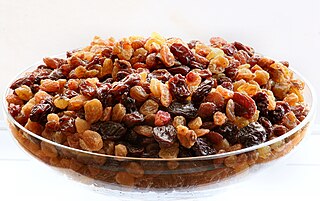
A raisin is a dried grape. Raisins are produced in many regions of the world and may be eaten raw or used in cooking, baking, and brewing. In the United Kingdom, Ireland, New Zealand, Australia and South Africa, the word raisin is reserved for the dark-colored dried large grape, with sultana being a golden- or green-colored dried grape, and currant being a dried small Black Corinth seedless grape.
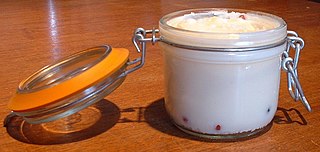
Tallow is a rendered form of beef or mutton suet, primarily made up of triglycerides.

Gummy bears are small, fruit gum candies, similar to a jelly baby in some English-speaking countries. The candy is roughly 2 cm (0.8 in) long and shaped in the form of a bear. The gummy bear is one of many gummies, popular gelatin-based candies sold in a variety of shapes and colors by various brands such as Haribo.
Shoepeg corn is a cultivar of white sweetcorn valued for its sweetness. It is characterized by small, narrow kernels tightly and unevenly packed on the cob. The corn has a sweet, mild flavor. The most common variety of shoepeg corn available today is Country Gentleman.

Nutritional yeast is a deactivated yeast, often a strain of Saccharomyces cerevisiae, that is sold commercially as a food product. It is sold in the form of yellow flakes, granules, or powder, and may be found in the bulk aisle of natural food stores. It is used in vegan and vegetarian cooking as an ingredient in recipes or as a condiment.
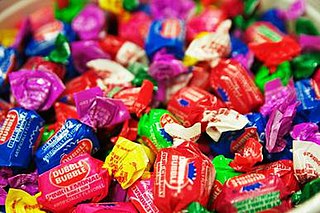
Dubble Bubble is an American brand of fruit-flavored, usually pink-colored, bubble gum invented by Walter Diemer, an accountant at Philadelphia-based Fleer Chewing Gum Company in 1928. One of Diemer's hobbies was concocting recipes for chewing gum based on the original Fleer ingredients. Though founder Frank H. Fleer had come up with his own bubble gum recipe under the name Blibber-Blubber in 1906, it was shelved due to its being too sticky and breaking apart too easily. It would be another 20 years until Diemer would use the original idea as inspiration for his invention.

Milk Duds are a brand of candies made with chocolate, created in 1928 by Hoffman and Company of Chicago and now produced and marketed by The Hershey Company, under license from owners of the brand, Highlander Partners, a Dallas-based global private equity firm.

Kinder Chocolate is a chocolate bar produced by Italian multinational confectionery company Ferrero.
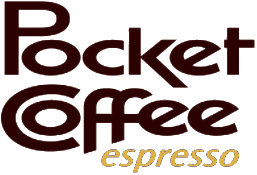
Pocket Coffee is a brand of the Ferrero company for a chocolate confectionery, sold internationally. First marketed in Italy in 1968, each Pocket Coffee is an individually wrapped shell of dark chocolate containing liquid espresso. As with Ferrero's Rocher, Mon Chéri, and Raffaello, production limits sales from November to April.
Charleston Chew is a candy bar consisting of marshmallow flavored nougat covered in chocolate flavor coating. It was created in 1922 by the Fox-Cross Candy Company, founded by stage actor Donley Cross and his friend Charlie Fox. The candy was named after the Charleston, a popular dance at that time.
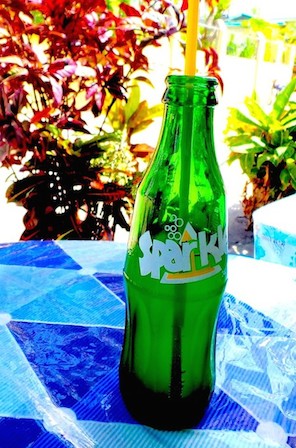
Sparkle was a brand for a lemon-flavored soft drink created by Cosmos Bottling Corporation for the provincial markets of the Philippines. Sparkle was sold in many stores in the Philippines and was very popular among children. Cosmos Bottling Corporation was later acquired by Coca-Cola Bottlers Philippines. The brand was later discontinued by Coca-Cola Bottlers Philippines and replaced by Royal Tru-Lemon.
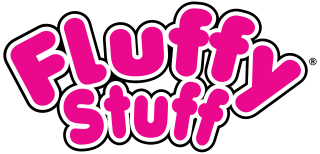
Fluffy Stuff is a brand of cotton candy sold in a variety of fruit flavors, marketed by Tootsie Roll Industries, which acquired it in 2000. It is the largest producer of cotton candy in the United States. The candy is packed in moisture-resistant, airtight bags, to prevent moisture and airborne contaminants from spoiling the product. It is available in popular seasonal varieties, including Snow Balls (December), Cotton Tails (Easter), and Spider Webs (Halloween).

Reese's Puffs is a corn-based breakfast cereal manufactured by General Mills inspired by Reese's Peanut Butter Cups. At its launch in May 1994 the cereal consisted of corn puffs flavored with chocolate and peanut butter. Later, the formula was revised to be a mixture of chocolate puffs and peanut butter puffs.

Kudos was a milk chocolate granola cereal bar produced by Mars, Incorporated.
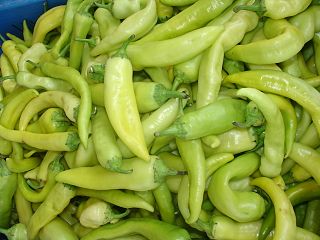
The banana pepper is an average-sized member of the chili pepper family that has a mild, tangy taste. While typically bright yellow, it is possible for them to change to green, red, or orange as they ripen. It is often pickled, stuffed or used as a raw ingredient in foods. It is a cultivar of the species Capsicum annuum. Its flavor is not very hot and, as is the case with most peppers, its heat depends on the maturity of the pepper, with the ripest being sweeter than younger ones.

Breakaway was a brand of chocolate-covered digestive biscuit from Nestlé, which started production in 1970 in the United Kingdom, manufactured by Rowntree Mackintosh Confectionery. Nestlé acquired the brand in 1988. It was discontinued in February 2024 after 54 years due to falling sales.

Tootsie Roll is a chocolate taffy candy that has been manufactured in the United States since 1907. The candy has qualities similar to both caramels and taffy without being exactly either confection. The manufacturer, Tootsie Roll Industries, is based in Chicago, Illinois. It was the first penny candy to be individually wrapped in America.

Fried potatoes are a dish or a component of other dishes essentially consisting of potatoes which have been fried or deep-fried in hot cooking oil often with the addition of salt and other seasonings. They are often served as a side dish.

Hershey's Cookies 'n' Mint is a candy bar manufactured by The Hershey Company. The bar is a flat, green candy bar containing bits of small uniformly-shaped mint-flavored cookie bits. It was introduced in 1994, then was discontinued. The bar was brought back in 2005, and was discontinued again, only to be brought back in 2020.



















